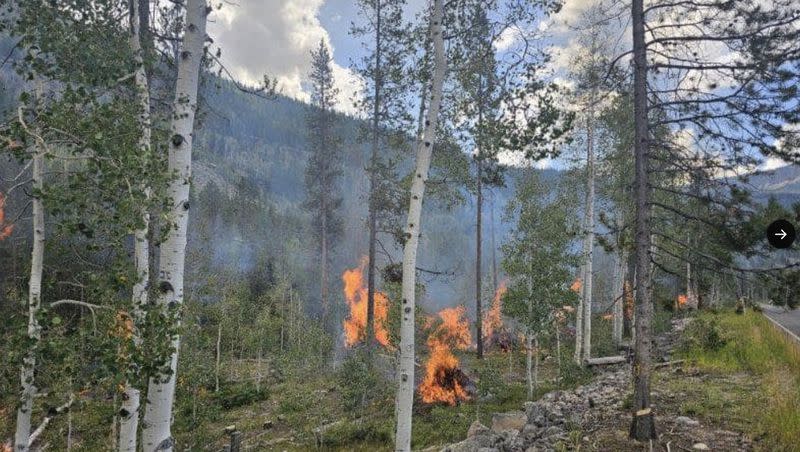Work begins to repair sections of Uinta Mountains years after beetle infestation

Justin Robinson remembers all too well what happened to many of the large pine and spruce trees that once boosted the Uinta Mountains' radiant green hues in northeast Utah and southwest Wyoming, a popular area for outdoor recreation.
It all started when a pair of beetle species began an "uncharacteristically high" infestation in the early 2000s. The tiny insects, in their larval phase, gnawed on parts of trees, punching holes in them and killing them left and right, says Robinson, district ranger for the U.S. Forest Service's Evanston-Mountain View Ranger District, a section of the Uinta-Wasatch-Cache National Forest.
The scene, he says, was somewhat reminiscent of the infamous cricket infestation that destroyed Utah pioneer crops in 1848.
"One year they just got perfect conditions and they blew up, and they were killing a lot of trees," he told KSL.com on Tuesday, adding the infestations came in waves over several years. "They really devastated our live trees."
The Forest Service estimates the beetles killed about two-thirds of the north slope's lodgepole pine and Engelmann spruce trees over a seven-year span. Some sections of the land experienced mortality rates as high as 95%.
The gray, lifeless trees remain on the land to this day, serving as a visual reminder of the toll the outbreak had on the landscape. The dead trees also pose a major potential fire risk, which could have severe ramifications on the water, wildlife and homes in the region.
But that is all beginning to change as the U.S. Forest Service starts its Anadarko Vegetation Management Project. The plan calls for a mixture of prescribed fires, forest thinning and timber sales to reduce wildfire threats across almost 70,000 acres of land in the area, carried out in several smaller pieces over the next 10 years.
Robinson said crews already started clearing out some of the "low-hanging fruit" within a few hundred acres in the Uinta Mountains as a part of a few different projects happening at the same time. Those who drive on the Mirror Lake Highway may notice more "massive" slash piles along the road as part of the project.
The agency posted on X, formerly known as Twitter, last week that crews burned 125 piles across 5 acres near the Cobblerest Campground, and Robinson says more burns are likely in the next few months, especially closer to Whitney Reservoir.
#uwcnf Fire personnel on Heber-Kamas Ranger District burned 125 piles for 5 acres along the Mirror Lake Highway SR 150 Thursday, September 14th. Crews will be in the area today, Friday, September 15th monitoring the piles. pic.twitter.com/1GkxgjK63E
— Uinta-Wasatch-Cache NF (@UWCNF) September 15, 2023
Some work specifically tied to the Anadarko project could also begin as early as this fall, focusing on the Mill Creek area, also near the highway in the forest's northern boundary in Wyoming, he adds. Heavier work won't likely begin until next year, though, as the agency finalizes its environmental analysis and additional surveys to protect historical resources on the land.
Robinson said the earliest work will target trees near existing fuel breaks, which are gaps in vegetation that aim to stop fires from spreading.
The agency's primary goal is to reduce the risk or effects of wildfires by adding more fuel breaks closer to homes and the major watersheds in the region, such as the Bear and Green rivers. The two rivers supply water to communities across sections of Utah, Idaho and Wyoming, and serve as tributaries for the Great Salt Lake and Colorado River.
"We can see benefits as early as next year when we have enough acres treated to really defend those sites," Robinson said. "Everything we add to it will just be strategic on top of that, just to give us stronger and stronger defense."
That's not to say trees will permanently disappear from the landscape, because it is considered a major wildlife corridor. The Forest Service anticipates lodgepole pines will regrow on their own, as the species typically releases its seeds during fires. Robinson said the agency also plans to replant spruce, fir and other vegetation in areas where it sees fit, helping restore the lively vegetation that once existed before the beetle infestation all those years ago.
Similar work like this is expected all across the Uinta-Wasatch-Cache National Forest over the next decade, too.
The Forest Service announced in January it would send $18.25 million from the Bipartisan Infrastructure Law and the Inflation Reduction Act for "cross-boundary mechanical treatments," including prescribed fires and "creating or strengthening" fire lines as a part of the agency's "Confronting the Wildfire Crisis" plan.
Forest Service officials said crews would treat at least 105,000 acres over the next 7 to 10 years, with most of the work focusing on "high or very high" fire hazard areas near the Wasatch Front. As with the Anadarko project, agency officials said they want to protect communities and natural resources.
"It is no longer a matter of if a wildfire will threaten many western communities in these landscapes, it is a matter of when," Department of Agriculture Secretary Tom Vilsack said at the time. "The need to invest more and to move quickly is apparent."

